Nestle Australia: Analysis of WHS Failures and Taxation Policy Effects
VerifiedAdded on 2023/01/05
|13
|3262
|96
Report
AI Summary
This report provides a comprehensive analysis of Nestle Australia's operational challenges, focusing on two primary areas: Work Health and Safety (WHS) failures and the impact of taxation policies. The WHS section details the company's non-compliance with safety regulations, specifically highlighting issues related to unsafe storage practices, inadequate aisle clearances, and the resulting hazards. It explores the impact of these failures on employee safety, compensation, and the company's legal standing, including monetary penalties and investigations. The report also examines the implications of Australia's taxation policies, particularly the Goods and Services Tax (GST), on Nestle Australia's dairy product sales. It discusses the effects of the GST on online retailers and the company's efforts to comply with and adapt to the new tax regulations, including the establishment of a Consumer Welfare Fund. The report analyzes the impact of these policies on Nestle's dairy production and competition, concluding with recommendations for improved compliance and business strategies.
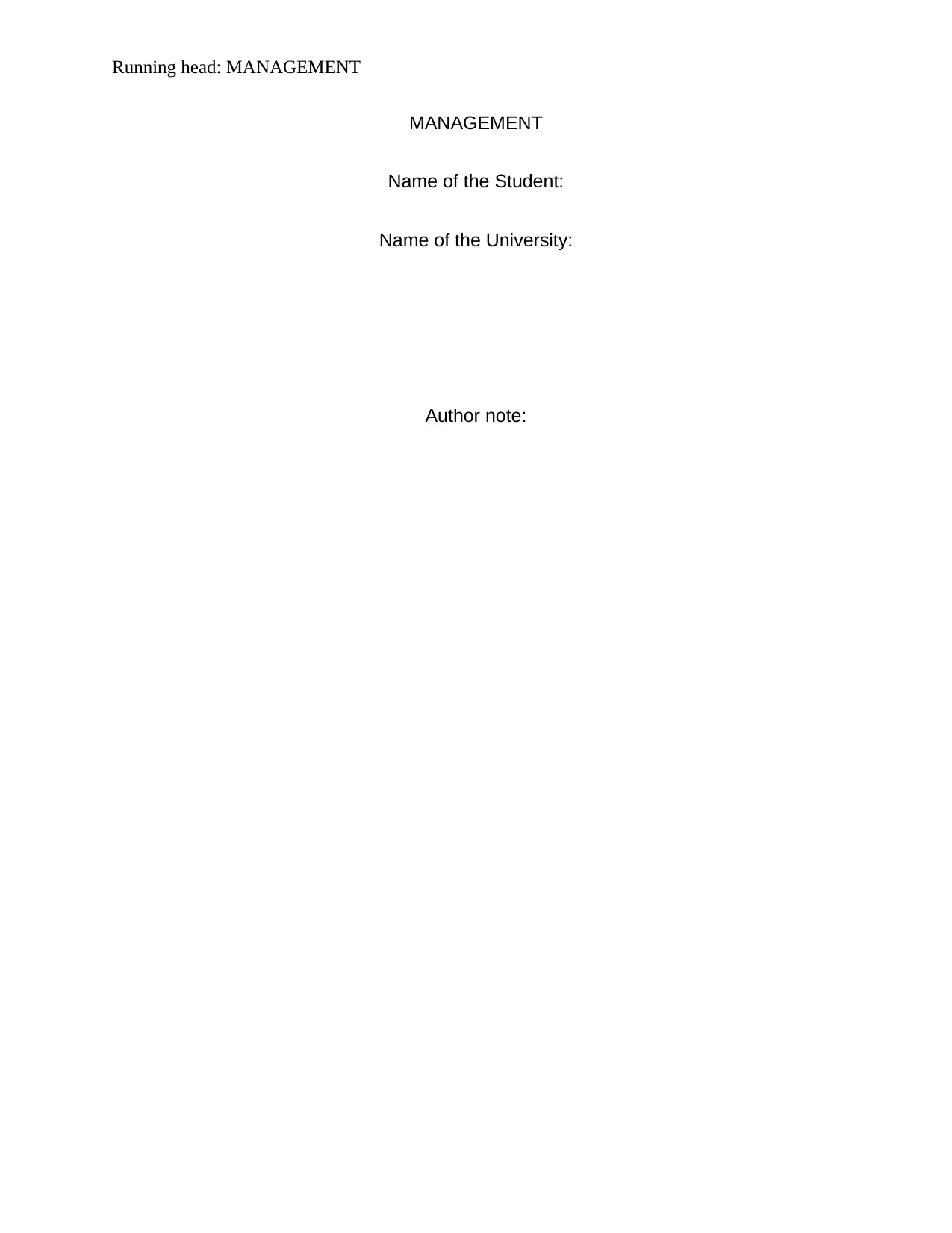
Running head: MANAGEMENT
MANAGEMENT
Name of the Student:
Name of the University:
Author note:
MANAGEMENT
Name of the Student:
Name of the University:
Author note:
Paraphrase This Document
Need a fresh take? Get an instant paraphrase of this document with our AI Paraphraser
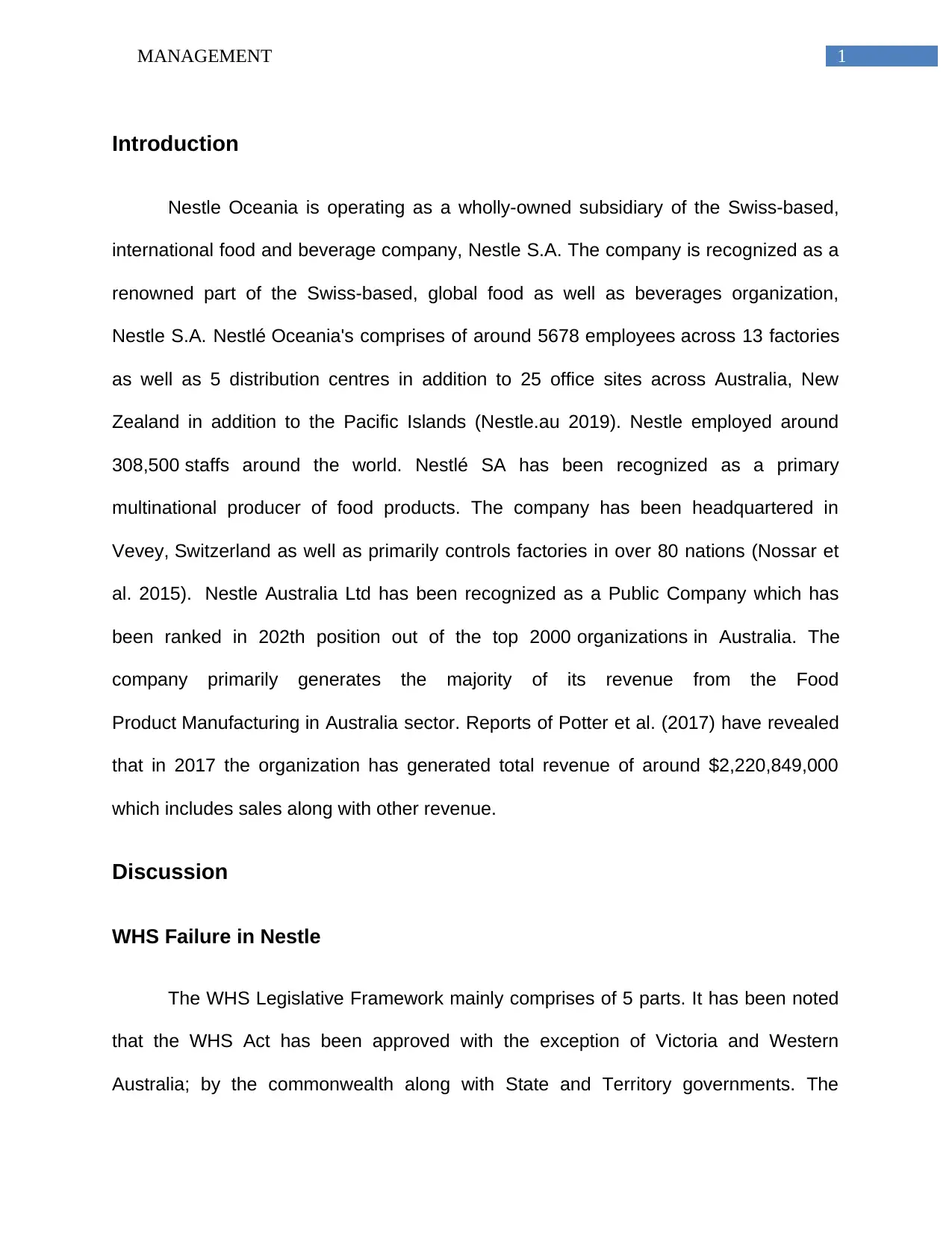
1MANAGEMENT
Introduction
Nestle Oceania is operating as a wholly-owned subsidiary of the Swiss-based,
international food and beverage company, Nestle S.A. The company is recognized as a
renowned part of the Swiss-based, global food as well as beverages organization,
Nestle S.A. Nestlé Oceania's comprises of around 5678 employees across 13 factories
as well as 5 distribution centres in addition to 25 office sites across Australia, New
Zealand in addition to the Pacific Islands (Nestle.au 2019). Nestle employed around
308,500 staffs around the world. Nestlé SA has been recognized as a primary
multinational producer of food products. The company has been headquartered in
Vevey, Switzerland as well as primarily controls factories in over 80 nations (Nossar et
al. 2015). Nestle Australia Ltd has been recognized as a Public Company which has
been ranked in 202th position out of the top 2000 organizations in Australia. The
company primarily generates the majority of its revenue from the Food
Product Manufacturing in Australia sector. Reports of Potter et al. (2017) have revealed
that in 2017 the organization has generated total revenue of around $2,220,849,000
which includes sales along with other revenue.
Discussion
WHS Failure in Nestle
The WHS Legislative Framework mainly comprises of 5 parts. It has been noted
that the WHS Act has been approved with the exception of Victoria and Western
Australia; by the commonwealth along with State and Territory governments. The
Introduction
Nestle Oceania is operating as a wholly-owned subsidiary of the Swiss-based,
international food and beverage company, Nestle S.A. The company is recognized as a
renowned part of the Swiss-based, global food as well as beverages organization,
Nestle S.A. Nestlé Oceania's comprises of around 5678 employees across 13 factories
as well as 5 distribution centres in addition to 25 office sites across Australia, New
Zealand in addition to the Pacific Islands (Nestle.au 2019). Nestle employed around
308,500 staffs around the world. Nestlé SA has been recognized as a primary
multinational producer of food products. The company has been headquartered in
Vevey, Switzerland as well as primarily controls factories in over 80 nations (Nossar et
al. 2015). Nestle Australia Ltd has been recognized as a Public Company which has
been ranked in 202th position out of the top 2000 organizations in Australia. The
company primarily generates the majority of its revenue from the Food
Product Manufacturing in Australia sector. Reports of Potter et al. (2017) have revealed
that in 2017 the organization has generated total revenue of around $2,220,849,000
which includes sales along with other revenue.
Discussion
WHS Failure in Nestle
The WHS Legislative Framework mainly comprises of 5 parts. It has been noted
that the WHS Act has been approved with the exception of Victoria and Western
Australia; by the commonwealth along with State and Territory governments. The
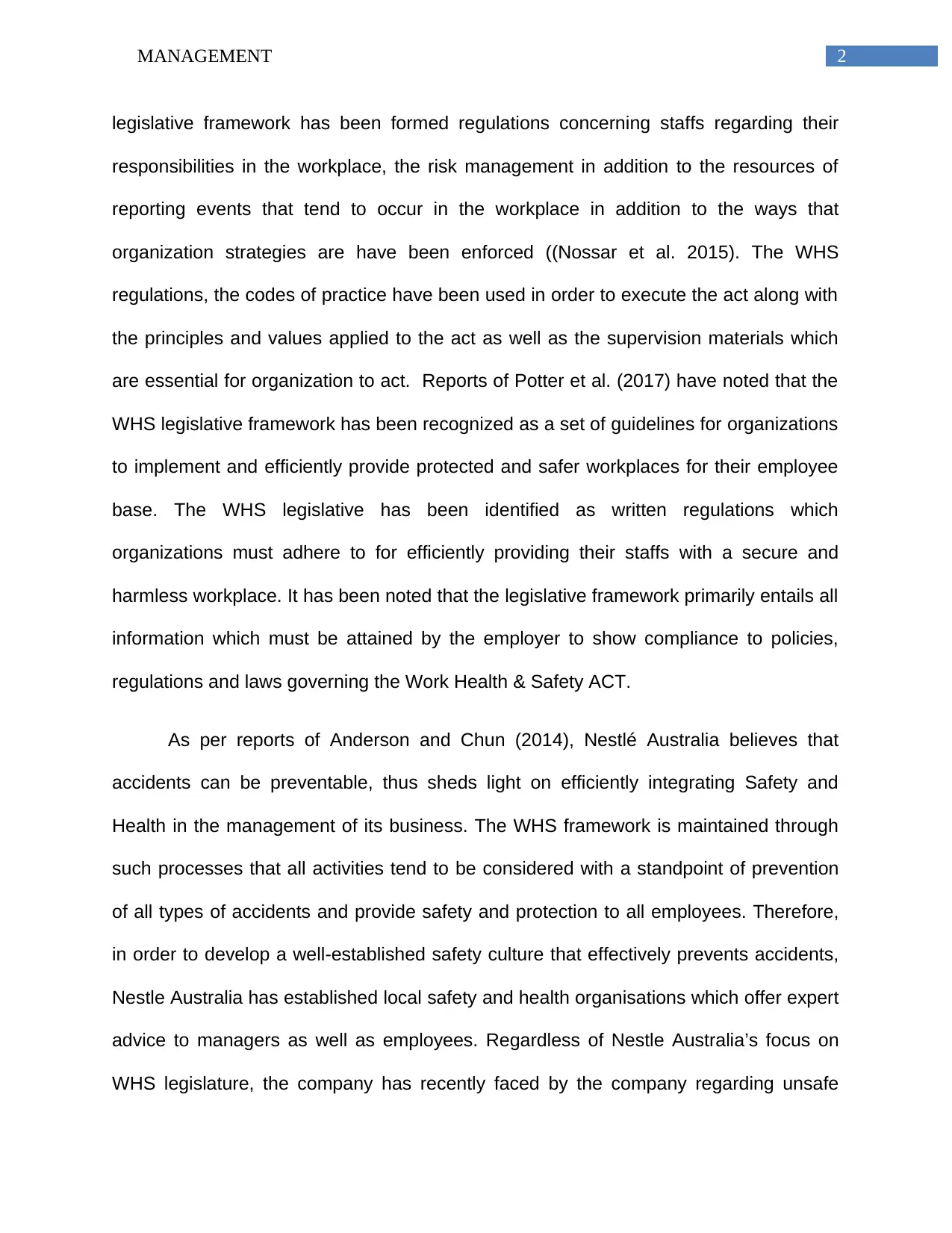
2MANAGEMENT
legislative framework has been formed regulations concerning staffs regarding their
responsibilities in the workplace, the risk management in addition to the resources of
reporting events that tend to occur in the workplace in addition to the ways that
organization strategies are have been enforced ((Nossar et al. 2015). The WHS
regulations, the codes of practice have been used in order to execute the act along with
the principles and values applied to the act as well as the supervision materials which
are essential for organization to act. Reports of Potter et al. (2017) have noted that the
WHS legislative framework has been recognized as a set of guidelines for organizations
to implement and efficiently provide protected and safer workplaces for their employee
base. The WHS legislative has been identified as written regulations which
organizations must adhere to for efficiently providing their staffs with a secure and
harmless workplace. It has been noted that the legislative framework primarily entails all
information which must be attained by the employer to show compliance to policies,
regulations and laws governing the Work Health & Safety ACT.
As per reports of Anderson and Chun (2014), Nestlé Australia believes that
accidents can be preventable, thus sheds light on efficiently integrating Safety and
Health in the management of its business. The WHS framework is maintained through
such processes that all activities tend to be considered with a standpoint of prevention
of all types of accidents and provide safety and protection to all employees. Therefore,
in order to develop a well-established safety culture that effectively prevents accidents,
Nestle Australia has established local safety and health organisations which offer expert
advice to managers as well as employees. Regardless of Nestle Australia’s focus on
WHS legislature, the company has recently faced by the company regarding unsafe
legislative framework has been formed regulations concerning staffs regarding their
responsibilities in the workplace, the risk management in addition to the resources of
reporting events that tend to occur in the workplace in addition to the ways that
organization strategies are have been enforced ((Nossar et al. 2015). The WHS
regulations, the codes of practice have been used in order to execute the act along with
the principles and values applied to the act as well as the supervision materials which
are essential for organization to act. Reports of Potter et al. (2017) have noted that the
WHS legislative framework has been recognized as a set of guidelines for organizations
to implement and efficiently provide protected and safer workplaces for their employee
base. The WHS legislative has been identified as written regulations which
organizations must adhere to for efficiently providing their staffs with a secure and
harmless workplace. It has been noted that the legislative framework primarily entails all
information which must be attained by the employer to show compliance to policies,
regulations and laws governing the Work Health & Safety ACT.
As per reports of Anderson and Chun (2014), Nestlé Australia believes that
accidents can be preventable, thus sheds light on efficiently integrating Safety and
Health in the management of its business. The WHS framework is maintained through
such processes that all activities tend to be considered with a standpoint of prevention
of all types of accidents and provide safety and protection to all employees. Therefore,
in order to develop a well-established safety culture that effectively prevents accidents,
Nestle Australia has established local safety and health organisations which offer expert
advice to managers as well as employees. Regardless of Nestle Australia’s focus on
WHS legislature, the company has recently faced by the company regarding unsafe
⊘ This is a preview!⊘
Do you want full access?
Subscribe today to unlock all pages.

Trusted by 1+ million students worldwide
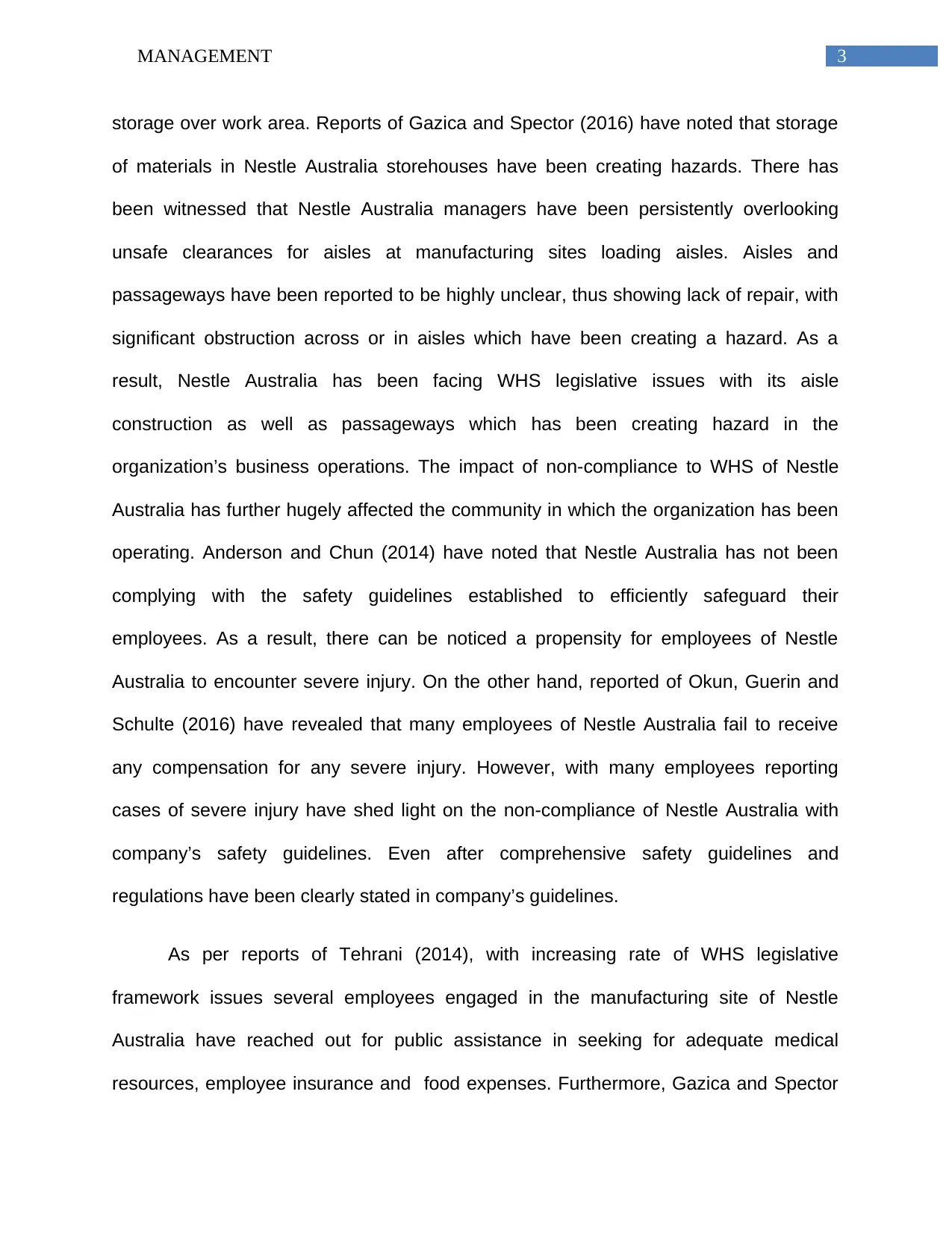
3MANAGEMENT
storage over work area. Reports of Gazica and Spector (2016) have noted that storage
of materials in Nestle Australia storehouses have been creating hazards. There has
been witnessed that Nestle Australia managers have been persistently overlooking
unsafe clearances for aisles at manufacturing sites loading aisles. Aisles and
passageways have been reported to be highly unclear, thus showing lack of repair, with
significant obstruction across or in aisles which have been creating a hazard. As a
result, Nestle Australia has been facing WHS legislative issues with its aisle
construction as well as passageways which has been creating hazard in the
organization’s business operations. The impact of non-compliance to WHS of Nestle
Australia has further hugely affected the community in which the organization has been
operating. Anderson and Chun (2014) have noted that Nestle Australia has not been
complying with the safety guidelines established to efficiently safeguard their
employees. As a result, there can be noticed a propensity for employees of Nestle
Australia to encounter severe injury. On the other hand, reported of Okun, Guerin and
Schulte (2016) have revealed that many employees of Nestle Australia fail to receive
any compensation for any severe injury. However, with many employees reporting
cases of severe injury have shed light on the non-compliance of Nestle Australia with
company’s safety guidelines. Even after comprehensive safety guidelines and
regulations have been clearly stated in company’s guidelines.
As per reports of Tehrani (2014), with increasing rate of WHS legislative
framework issues several employees engaged in the manufacturing site of Nestle
Australia have reached out for public assistance in seeking for adequate medical
resources, employee insurance and food expenses. Furthermore, Gazica and Spector
storage over work area. Reports of Gazica and Spector (2016) have noted that storage
of materials in Nestle Australia storehouses have been creating hazards. There has
been witnessed that Nestle Australia managers have been persistently overlooking
unsafe clearances for aisles at manufacturing sites loading aisles. Aisles and
passageways have been reported to be highly unclear, thus showing lack of repair, with
significant obstruction across or in aisles which have been creating a hazard. As a
result, Nestle Australia has been facing WHS legislative issues with its aisle
construction as well as passageways which has been creating hazard in the
organization’s business operations. The impact of non-compliance to WHS of Nestle
Australia has further hugely affected the community in which the organization has been
operating. Anderson and Chun (2014) have noted that Nestle Australia has not been
complying with the safety guidelines established to efficiently safeguard their
employees. As a result, there can be noticed a propensity for employees of Nestle
Australia to encounter severe injury. On the other hand, reported of Okun, Guerin and
Schulte (2016) have revealed that many employees of Nestle Australia fail to receive
any compensation for any severe injury. However, with many employees reporting
cases of severe injury have shed light on the non-compliance of Nestle Australia with
company’s safety guidelines. Even after comprehensive safety guidelines and
regulations have been clearly stated in company’s guidelines.
As per reports of Tehrani (2014), with increasing rate of WHS legislative
framework issues several employees engaged in the manufacturing site of Nestle
Australia have reached out for public assistance in seeking for adequate medical
resources, employee insurance and food expenses. Furthermore, Gazica and Spector
Paraphrase This Document
Need a fresh take? Get an instant paraphrase of this document with our AI Paraphraser
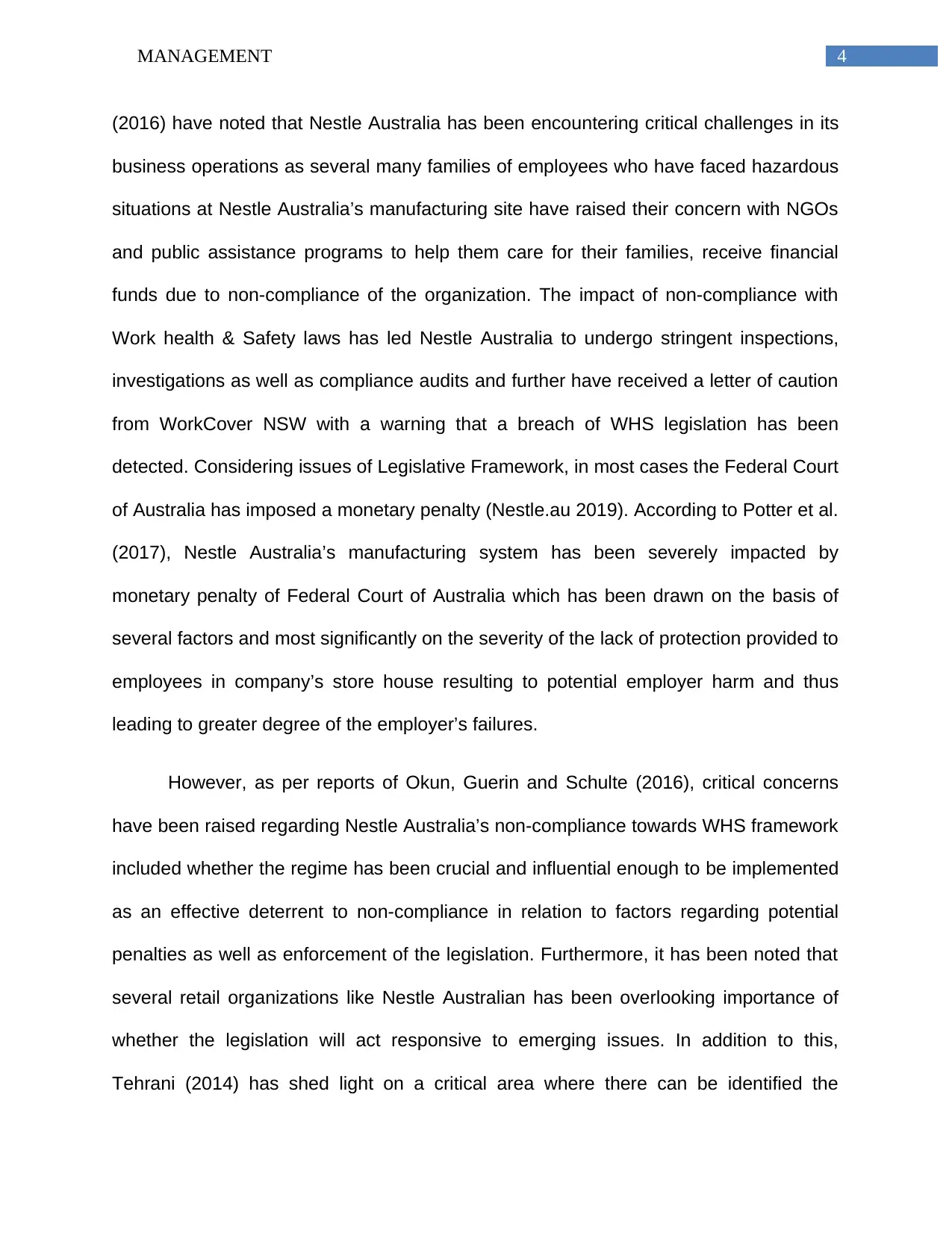
4MANAGEMENT
(2016) have noted that Nestle Australia has been encountering critical challenges in its
business operations as several many families of employees who have faced hazardous
situations at Nestle Australia’s manufacturing site have raised their concern with NGOs
and public assistance programs to help them care for their families, receive financial
funds due to non-compliance of the organization. The impact of non-compliance with
Work health & Safety laws has led Nestle Australia to undergo stringent inspections,
investigations as well as compliance audits and further have received a letter of caution
from WorkCover NSW with a warning that a breach of WHS legislation has been
detected. Considering issues of Legislative Framework, in most cases the Federal Court
of Australia has imposed a monetary penalty (Nestle.au 2019). According to Potter et al.
(2017), Nestle Australia’s manufacturing system has been severely impacted by
monetary penalty of Federal Court of Australia which has been drawn on the basis of
several factors and most significantly on the severity of the lack of protection provided to
employees in company’s store house resulting to potential employer harm and thus
leading to greater degree of the employer’s failures.
However, as per reports of Okun, Guerin and Schulte (2016), critical concerns
have been raised regarding Nestle Australia’s non-compliance towards WHS framework
included whether the regime has been crucial and influential enough to be implemented
as an effective deterrent to non-compliance in relation to factors regarding potential
penalties as well as enforcement of the legislation. Furthermore, it has been noted that
several retail organizations like Nestle Australian has been overlooking importance of
whether the legislation will act responsive to emerging issues. In addition to this,
Tehrani (2014) has shed light on a critical area where there can be identified the
(2016) have noted that Nestle Australia has been encountering critical challenges in its
business operations as several many families of employees who have faced hazardous
situations at Nestle Australia’s manufacturing site have raised their concern with NGOs
and public assistance programs to help them care for their families, receive financial
funds due to non-compliance of the organization. The impact of non-compliance with
Work health & Safety laws has led Nestle Australia to undergo stringent inspections,
investigations as well as compliance audits and further have received a letter of caution
from WorkCover NSW with a warning that a breach of WHS legislation has been
detected. Considering issues of Legislative Framework, in most cases the Federal Court
of Australia has imposed a monetary penalty (Nestle.au 2019). According to Potter et al.
(2017), Nestle Australia’s manufacturing system has been severely impacted by
monetary penalty of Federal Court of Australia which has been drawn on the basis of
several factors and most significantly on the severity of the lack of protection provided to
employees in company’s store house resulting to potential employer harm and thus
leading to greater degree of the employer’s failures.
However, as per reports of Okun, Guerin and Schulte (2016), critical concerns
have been raised regarding Nestle Australia’s non-compliance towards WHS framework
included whether the regime has been crucial and influential enough to be implemented
as an effective deterrent to non-compliance in relation to factors regarding potential
penalties as well as enforcement of the legislation. Furthermore, it has been noted that
several retail organizations like Nestle Australian has been overlooking importance of
whether the legislation will act responsive to emerging issues. In addition to this,
Tehrani (2014) has shed light on a critical area where there can be identified the
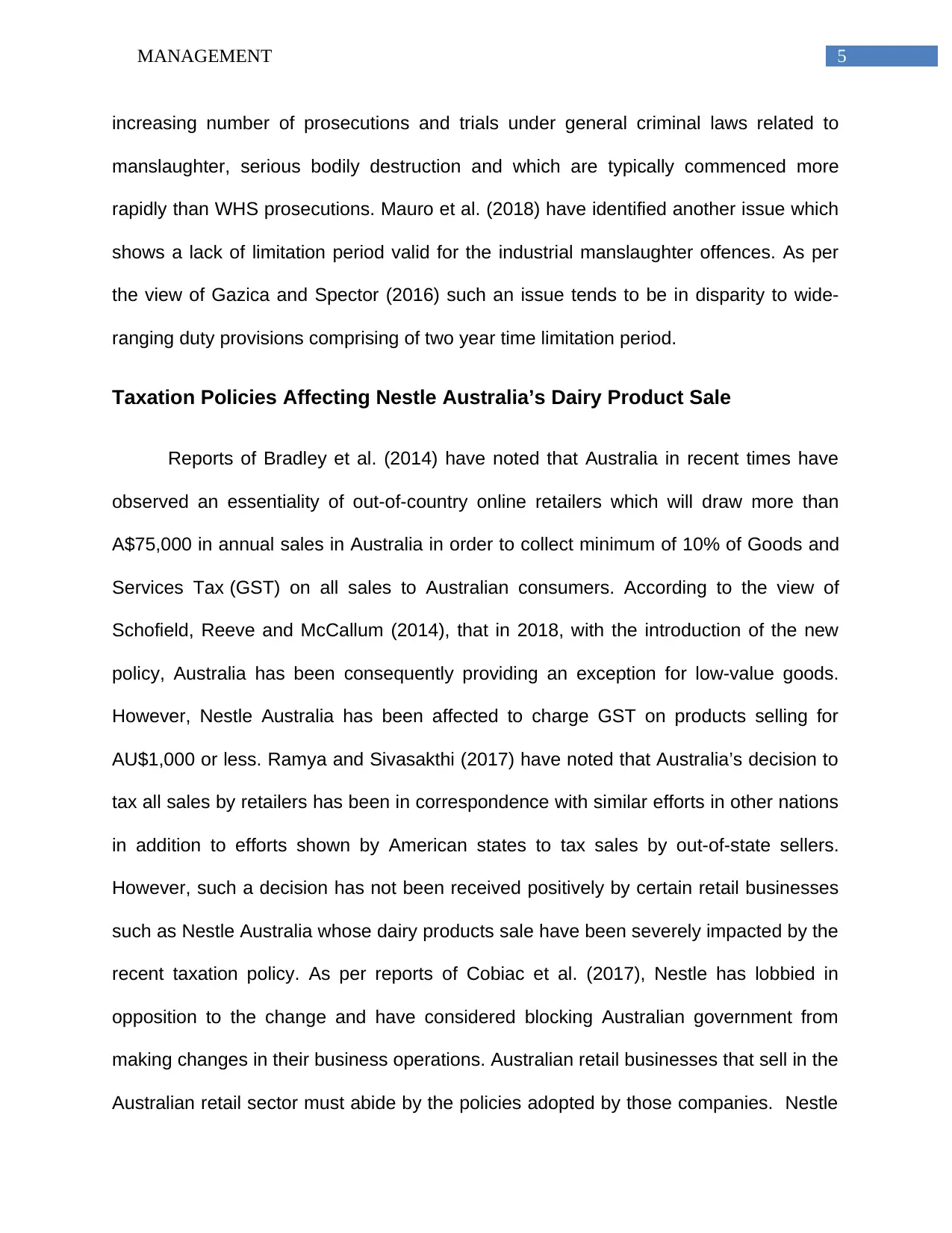
5MANAGEMENT
increasing number of prosecutions and trials under general criminal laws related to
manslaughter, serious bodily destruction and which are typically commenced more
rapidly than WHS prosecutions. Mauro et al. (2018) have identified another issue which
shows a lack of limitation period valid for the industrial manslaughter offences. As per
the view of Gazica and Spector (2016) such an issue tends to be in disparity to wide-
ranging duty provisions comprising of two year time limitation period.
Taxation Policies Affecting Nestle Australia’s Dairy Product Sale
Reports of Bradley et al. (2014) have noted that Australia in recent times have
observed an essentiality of out-of-country online retailers which will draw more than
A$75,000 in annual sales in Australia in order to collect minimum of 10% of Goods and
Services Tax (GST) on all sales to Australian consumers. According to the view of
Schofield, Reeve and McCallum (2014), that in 2018, with the introduction of the new
policy, Australia has been consequently providing an exception for low-value goods.
However, Nestle Australia has been affected to charge GST on products selling for
AU$1,000 or less. Ramya and Sivasakthi (2017) have noted that Australia’s decision to
tax all sales by retailers has been in correspondence with similar efforts in other nations
in addition to efforts shown by American states to tax sales by out-of-state sellers.
However, such a decision has not been received positively by certain retail businesses
such as Nestle Australia whose dairy products sale have been severely impacted by the
recent taxation policy. As per reports of Cobiac et al. (2017), Nestle has lobbied in
opposition to the change and have considered blocking Australian government from
making changes in their business operations. Australian retail businesses that sell in the
Australian retail sector must abide by the policies adopted by those companies. Nestle
increasing number of prosecutions and trials under general criminal laws related to
manslaughter, serious bodily destruction and which are typically commenced more
rapidly than WHS prosecutions. Mauro et al. (2018) have identified another issue which
shows a lack of limitation period valid for the industrial manslaughter offences. As per
the view of Gazica and Spector (2016) such an issue tends to be in disparity to wide-
ranging duty provisions comprising of two year time limitation period.
Taxation Policies Affecting Nestle Australia’s Dairy Product Sale
Reports of Bradley et al. (2014) have noted that Australia in recent times have
observed an essentiality of out-of-country online retailers which will draw more than
A$75,000 in annual sales in Australia in order to collect minimum of 10% of Goods and
Services Tax (GST) on all sales to Australian consumers. According to the view of
Schofield, Reeve and McCallum (2014), that in 2018, with the introduction of the new
policy, Australia has been consequently providing an exception for low-value goods.
However, Nestle Australia has been affected to charge GST on products selling for
AU$1,000 or less. Ramya and Sivasakthi (2017) have noted that Australia’s decision to
tax all sales by retailers has been in correspondence with similar efforts in other nations
in addition to efforts shown by American states to tax sales by out-of-state sellers.
However, such a decision has not been received positively by certain retail businesses
such as Nestle Australia whose dairy products sale have been severely impacted by the
recent taxation policy. As per reports of Cobiac et al. (2017), Nestle has lobbied in
opposition to the change and have considered blocking Australian government from
making changes in their business operations. Australian retail businesses that sell in the
Australian retail sector must abide by the policies adopted by those companies. Nestle
⊘ This is a preview!⊘
Do you want full access?
Subscribe today to unlock all pages.

Trusted by 1+ million students worldwide
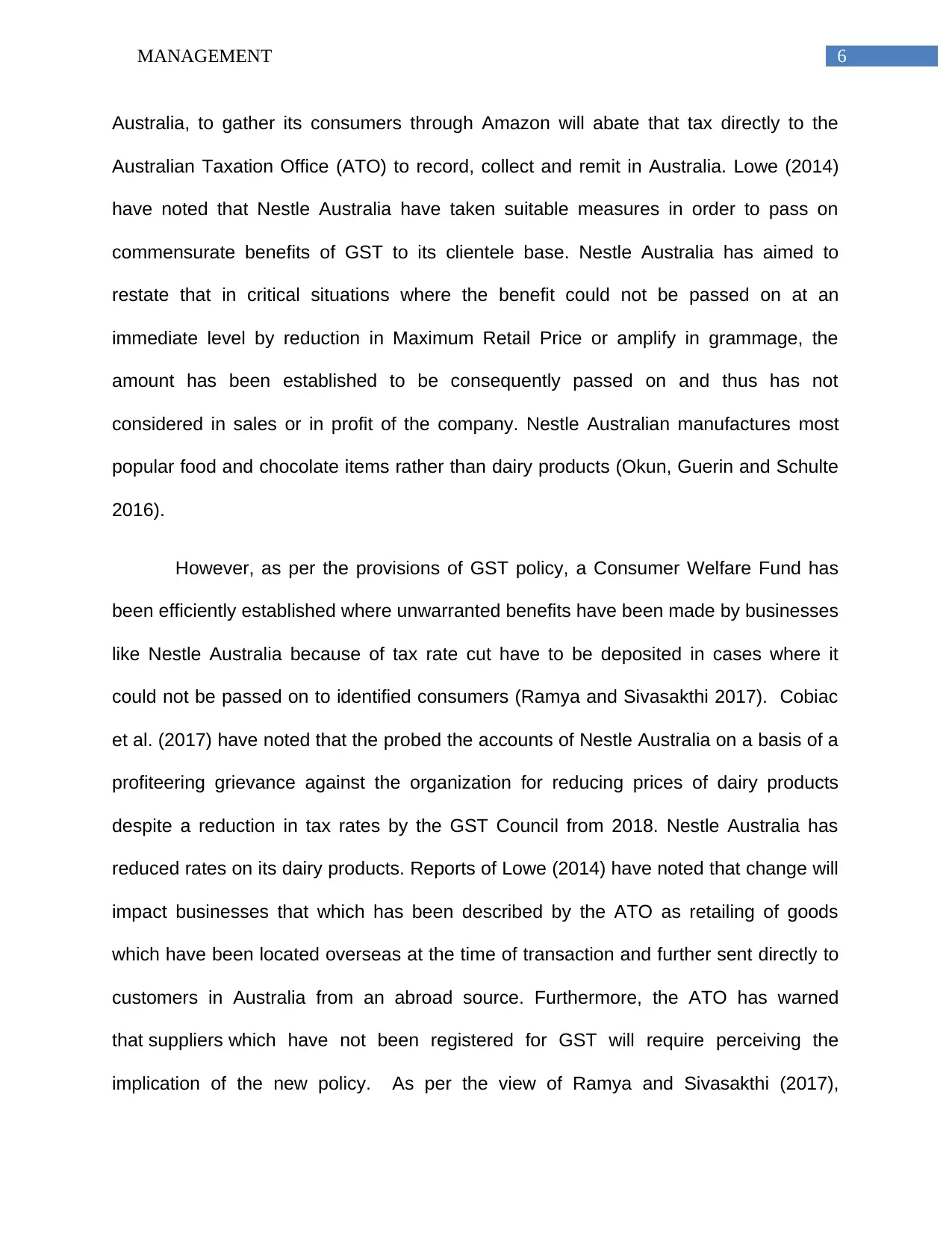
6MANAGEMENT
Australia, to gather its consumers through Amazon will abate that tax directly to the
Australian Taxation Office (ATO) to record, collect and remit in Australia. Lowe (2014)
have noted that Nestle Australia have taken suitable measures in order to pass on
commensurate benefits of GST to its clientele base. Nestle Australia has aimed to
restate that in critical situations where the benefit could not be passed on at an
immediate level by reduction in Maximum Retail Price or amplify in grammage, the
amount has been established to be consequently passed on and thus has not
considered in sales or in profit of the company. Nestle Australian manufactures most
popular food and chocolate items rather than dairy products (Okun, Guerin and Schulte
2016).
However, as per the provisions of GST policy, a Consumer Welfare Fund has
been efficiently established where unwarranted benefits have been made by businesses
like Nestle Australia because of tax rate cut have to be deposited in cases where it
could not be passed on to identified consumers (Ramya and Sivasakthi 2017). Cobiac
et al. (2017) have noted that the probed the accounts of Nestle Australia on a basis of a
profiteering grievance against the organization for reducing prices of dairy products
despite a reduction in tax rates by the GST Council from 2018. Nestle Australia has
reduced rates on its dairy products. Reports of Lowe (2014) have noted that change will
impact businesses that which has been described by the ATO as retailing of goods
which have been located overseas at the time of transaction and further sent directly to
customers in Australia from an abroad source. Furthermore, the ATO has warned
that suppliers which have not been registered for GST will require perceiving the
implication of the new policy. As per the view of Ramya and Sivasakthi (2017),
Australia, to gather its consumers through Amazon will abate that tax directly to the
Australian Taxation Office (ATO) to record, collect and remit in Australia. Lowe (2014)
have noted that Nestle Australia have taken suitable measures in order to pass on
commensurate benefits of GST to its clientele base. Nestle Australia has aimed to
restate that in critical situations where the benefit could not be passed on at an
immediate level by reduction in Maximum Retail Price or amplify in grammage, the
amount has been established to be consequently passed on and thus has not
considered in sales or in profit of the company. Nestle Australian manufactures most
popular food and chocolate items rather than dairy products (Okun, Guerin and Schulte
2016).
However, as per the provisions of GST policy, a Consumer Welfare Fund has
been efficiently established where unwarranted benefits have been made by businesses
like Nestle Australia because of tax rate cut have to be deposited in cases where it
could not be passed on to identified consumers (Ramya and Sivasakthi 2017). Cobiac
et al. (2017) have noted that the probed the accounts of Nestle Australia on a basis of a
profiteering grievance against the organization for reducing prices of dairy products
despite a reduction in tax rates by the GST Council from 2018. Nestle Australia has
reduced rates on its dairy products. Reports of Lowe (2014) have noted that change will
impact businesses that which has been described by the ATO as retailing of goods
which have been located overseas at the time of transaction and further sent directly to
customers in Australia from an abroad source. Furthermore, the ATO has warned
that suppliers which have not been registered for GST will require perceiving the
implication of the new policy. As per the view of Ramya and Sivasakthi (2017),
Paraphrase This Document
Need a fresh take? Get an instant paraphrase of this document with our AI Paraphraser
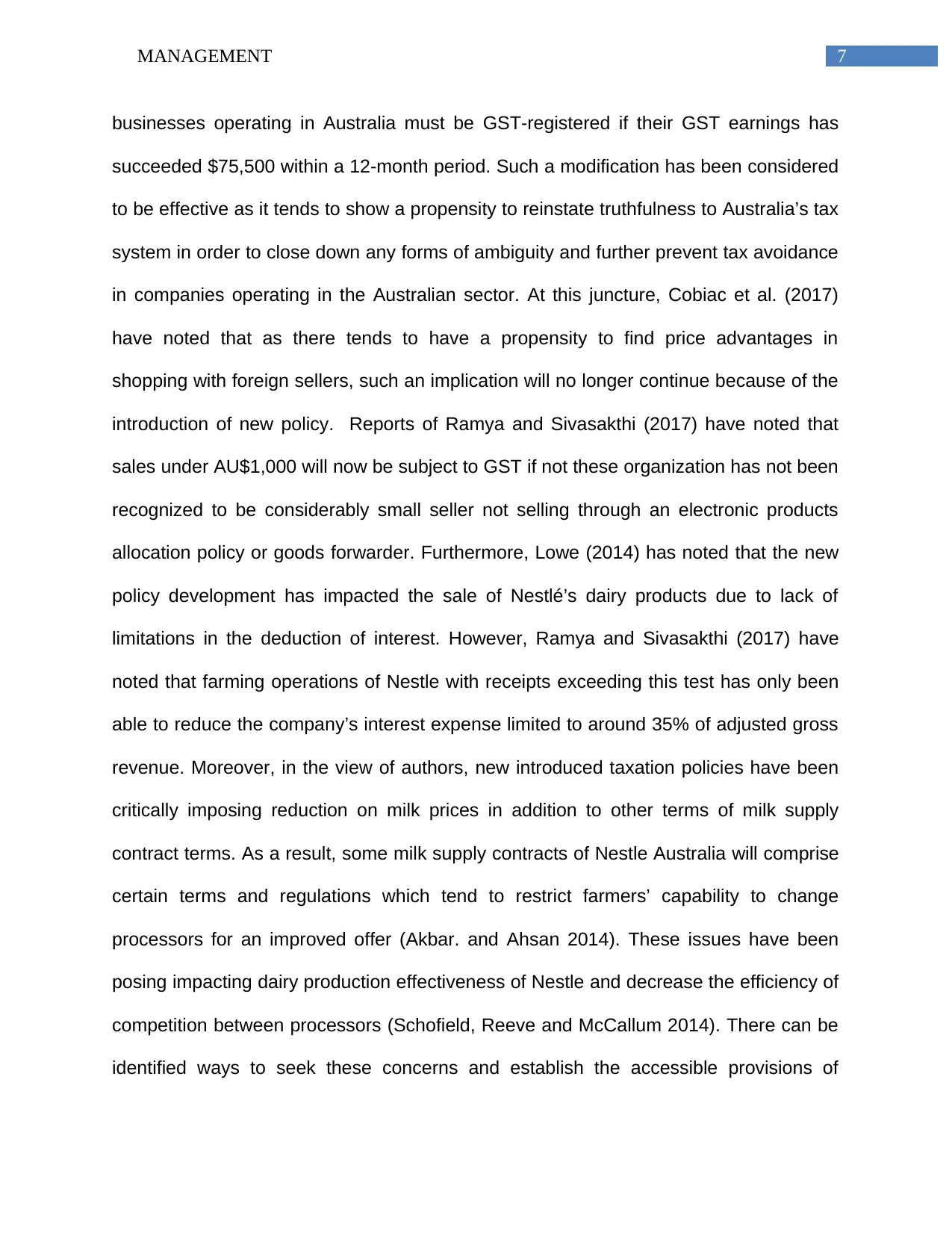
7MANAGEMENT
businesses operating in Australia must be GST-registered if their GST earnings has
succeeded $75,500 within a 12-month period. Such a modification has been considered
to be effective as it tends to show a propensity to reinstate truthfulness to Australia’s tax
system in order to close down any forms of ambiguity and further prevent tax avoidance
in companies operating in the Australian sector. At this juncture, Cobiac et al. (2017)
have noted that as there tends to have a propensity to find price advantages in
shopping with foreign sellers, such an implication will no longer continue because of the
introduction of new policy. Reports of Ramya and Sivasakthi (2017) have noted that
sales under AU$1,000 will now be subject to GST if not these organization has not been
recognized to be considerably small seller not selling through an electronic products
allocation policy or goods forwarder. Furthermore, Lowe (2014) has noted that the new
policy development has impacted the sale of Nestlé’s dairy products due to lack of
limitations in the deduction of interest. However, Ramya and Sivasakthi (2017) have
noted that farming operations of Nestle with receipts exceeding this test has only been
able to reduce the company’s interest expense limited to around 35% of adjusted gross
revenue. Moreover, in the view of authors, new introduced taxation policies have been
critically imposing reduction on milk prices in addition to other terms of milk supply
contract terms. As a result, some milk supply contracts of Nestle Australia will comprise
certain terms and regulations which tend to restrict farmers’ capability to change
processors for an improved offer (Akbar. and Ahsan 2014). These issues have been
posing impacting dairy production effectiveness of Nestle and decrease the efficiency of
competition between processors (Schofield, Reeve and McCallum 2014). There can be
identified ways to seek these concerns and establish the accessible provisions of
businesses operating in Australia must be GST-registered if their GST earnings has
succeeded $75,500 within a 12-month period. Such a modification has been considered
to be effective as it tends to show a propensity to reinstate truthfulness to Australia’s tax
system in order to close down any forms of ambiguity and further prevent tax avoidance
in companies operating in the Australian sector. At this juncture, Cobiac et al. (2017)
have noted that as there tends to have a propensity to find price advantages in
shopping with foreign sellers, such an implication will no longer continue because of the
introduction of new policy. Reports of Ramya and Sivasakthi (2017) have noted that
sales under AU$1,000 will now be subject to GST if not these organization has not been
recognized to be considerably small seller not selling through an electronic products
allocation policy or goods forwarder. Furthermore, Lowe (2014) has noted that the new
policy development has impacted the sale of Nestlé’s dairy products due to lack of
limitations in the deduction of interest. However, Ramya and Sivasakthi (2017) have
noted that farming operations of Nestle with receipts exceeding this test has only been
able to reduce the company’s interest expense limited to around 35% of adjusted gross
revenue. Moreover, in the view of authors, new introduced taxation policies have been
critically imposing reduction on milk prices in addition to other terms of milk supply
contract terms. As a result, some milk supply contracts of Nestle Australia will comprise
certain terms and regulations which tend to restrict farmers’ capability to change
processors for an improved offer (Akbar. and Ahsan 2014). These issues have been
posing impacting dairy production effectiveness of Nestle and decrease the efficiency of
competition between processors (Schofield, Reeve and McCallum 2014). There can be
identified ways to seek these concerns and establish the accessible provisions of
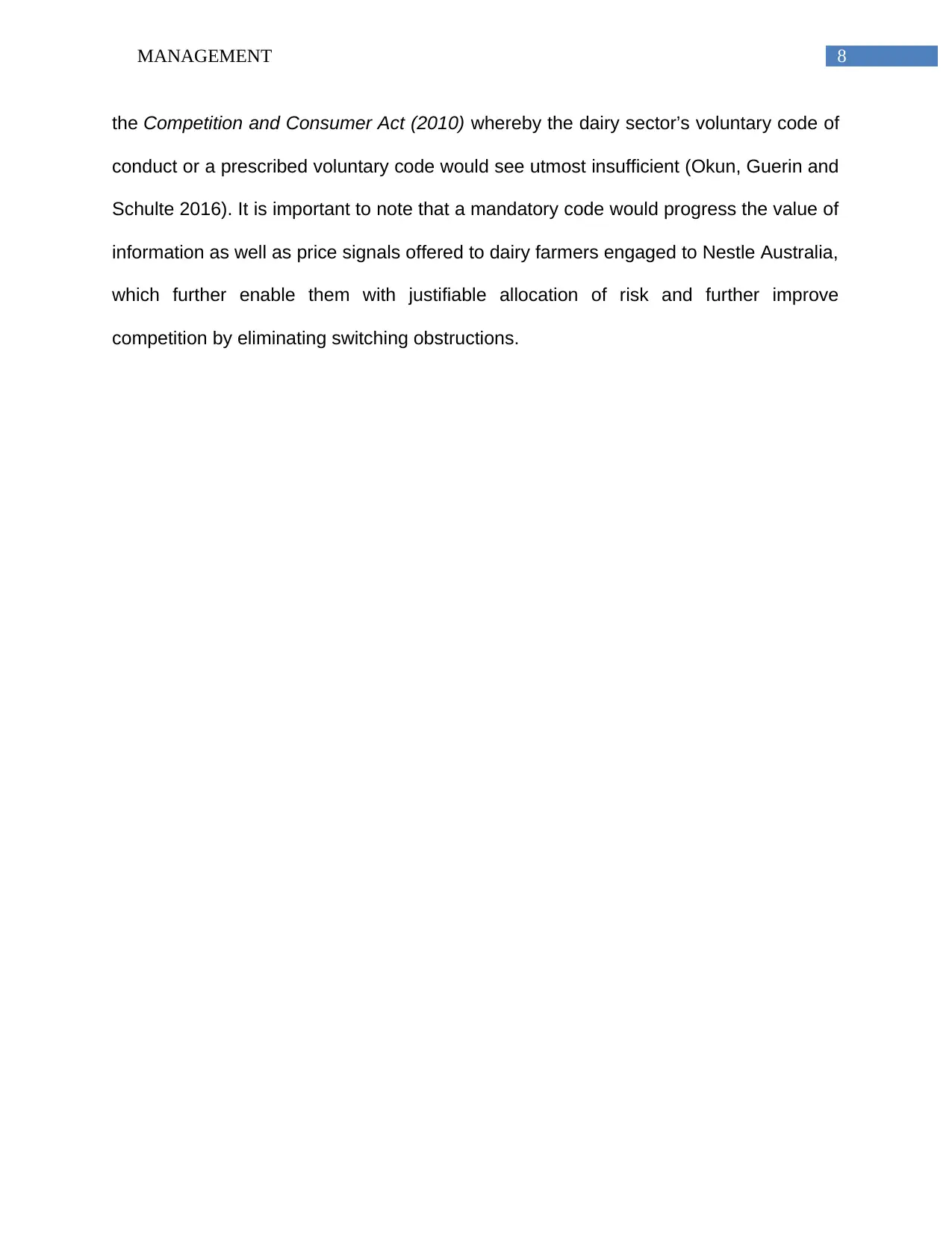
8MANAGEMENT
the Competition and Consumer Act (2010) whereby the dairy sector’s voluntary code of
conduct or a prescribed voluntary code would see utmost insufficient (Okun, Guerin and
Schulte 2016). It is important to note that a mandatory code would progress the value of
information as well as price signals offered to dairy farmers engaged to Nestle Australia,
which further enable them with justifiable allocation of risk and further improve
competition by eliminating switching obstructions.
the Competition and Consumer Act (2010) whereby the dairy sector’s voluntary code of
conduct or a prescribed voluntary code would see utmost insufficient (Okun, Guerin and
Schulte 2016). It is important to note that a mandatory code would progress the value of
information as well as price signals offered to dairy farmers engaged to Nestle Australia,
which further enable them with justifiable allocation of risk and further improve
competition by eliminating switching obstructions.
⊘ This is a preview!⊘
Do you want full access?
Subscribe today to unlock all pages.

Trusted by 1+ million students worldwide
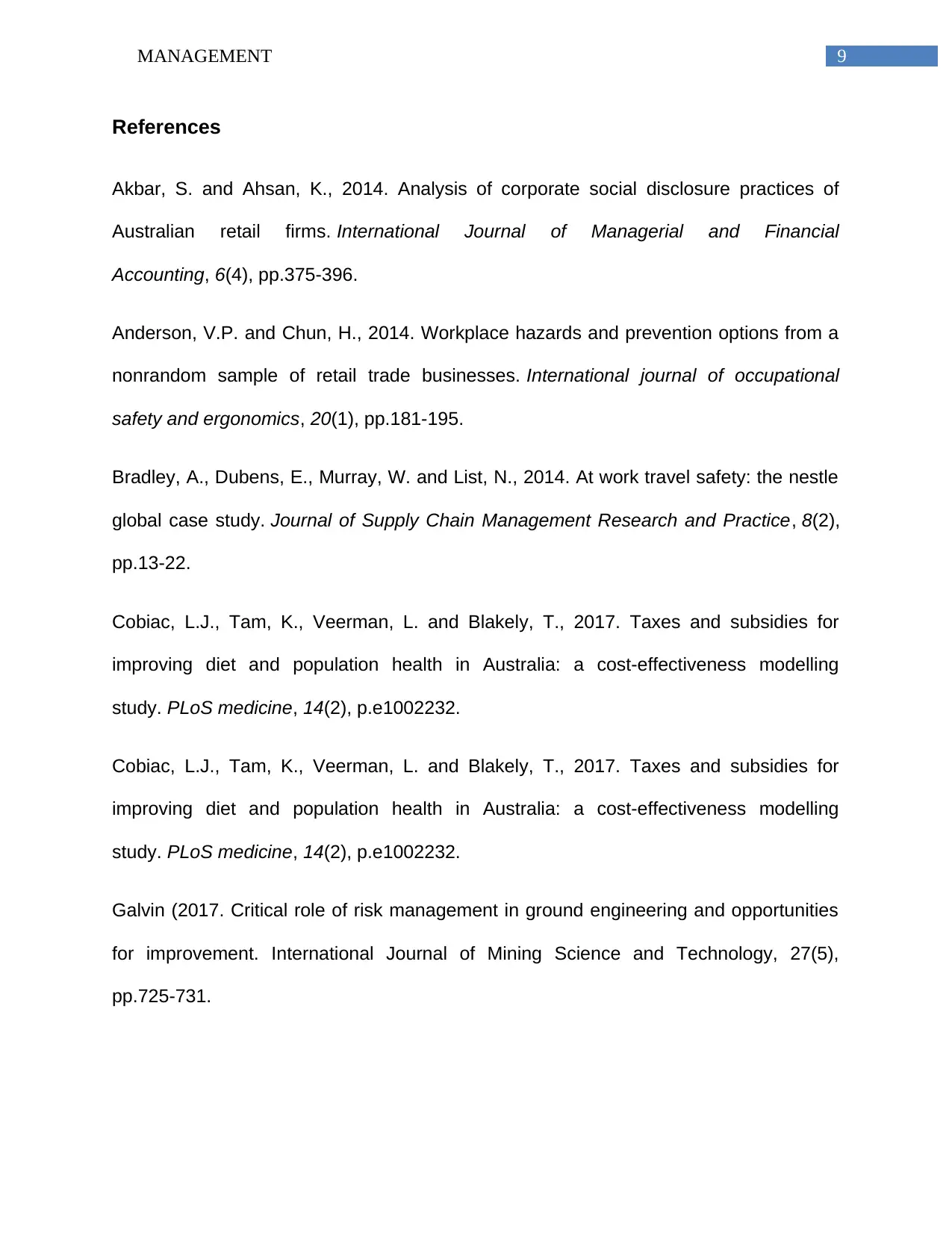
9MANAGEMENT
References
Akbar, S. and Ahsan, K., 2014. Analysis of corporate social disclosure practices of
Australian retail firms. International Journal of Managerial and Financial
Accounting, 6(4), pp.375-396.
Anderson, V.P. and Chun, H., 2014. Workplace hazards and prevention options from a
nonrandom sample of retail trade businesses. International journal of occupational
safety and ergonomics, 20(1), pp.181-195.
Bradley, A., Dubens, E., Murray, W. and List, N., 2014. At work travel safety: the nestle
global case study. Journal of Supply Chain Management Research and Practice, 8(2),
pp.13-22.
Cobiac, L.J., Tam, K., Veerman, L. and Blakely, T., 2017. Taxes and subsidies for
improving diet and population health in Australia: a cost-effectiveness modelling
study. PLoS medicine, 14(2), p.e1002232.
Cobiac, L.J., Tam, K., Veerman, L. and Blakely, T., 2017. Taxes and subsidies for
improving diet and population health in Australia: a cost-effectiveness modelling
study. PLoS medicine, 14(2), p.e1002232.
Galvin (2017. Critical role of risk management in ground engineering and opportunities
for improvement. International Journal of Mining Science and Technology, 27(5),
pp.725-731.
References
Akbar, S. and Ahsan, K., 2014. Analysis of corporate social disclosure practices of
Australian retail firms. International Journal of Managerial and Financial
Accounting, 6(4), pp.375-396.
Anderson, V.P. and Chun, H., 2014. Workplace hazards and prevention options from a
nonrandom sample of retail trade businesses. International journal of occupational
safety and ergonomics, 20(1), pp.181-195.
Bradley, A., Dubens, E., Murray, W. and List, N., 2014. At work travel safety: the nestle
global case study. Journal of Supply Chain Management Research and Practice, 8(2),
pp.13-22.
Cobiac, L.J., Tam, K., Veerman, L. and Blakely, T., 2017. Taxes and subsidies for
improving diet and population health in Australia: a cost-effectiveness modelling
study. PLoS medicine, 14(2), p.e1002232.
Cobiac, L.J., Tam, K., Veerman, L. and Blakely, T., 2017. Taxes and subsidies for
improving diet and population health in Australia: a cost-effectiveness modelling
study. PLoS medicine, 14(2), p.e1002232.
Galvin (2017. Critical role of risk management in ground engineering and opportunities
for improvement. International Journal of Mining Science and Technology, 27(5),
pp.725-731.
Paraphrase This Document
Need a fresh take? Get an instant paraphrase of this document with our AI Paraphraser
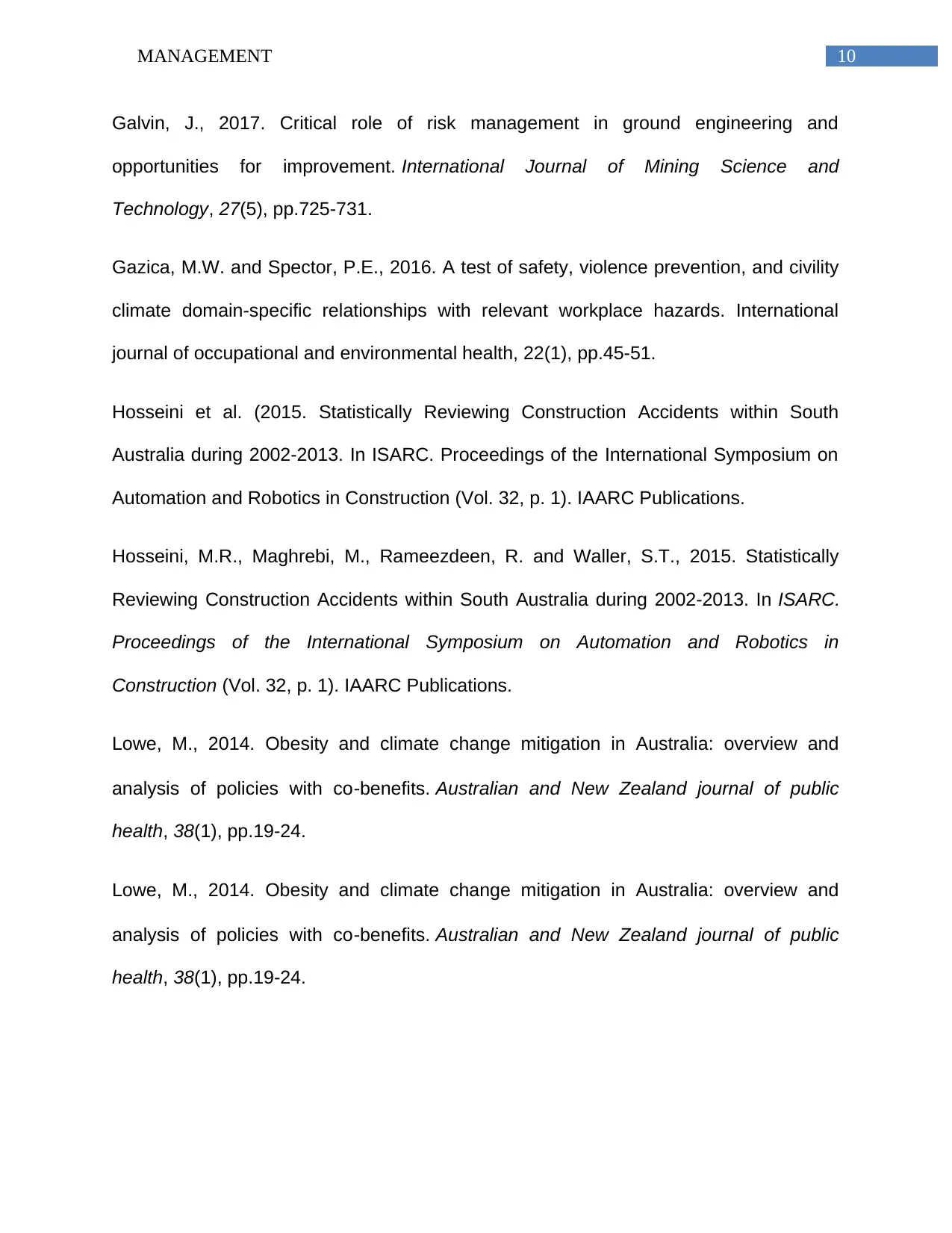
10MANAGEMENT
Galvin, J., 2017. Critical role of risk management in ground engineering and
opportunities for improvement. International Journal of Mining Science and
Technology, 27(5), pp.725-731.
Gazica, M.W. and Spector, P.E., 2016. A test of safety, violence prevention, and civility
climate domain-specific relationships with relevant workplace hazards. International
journal of occupational and environmental health, 22(1), pp.45-51.
Hosseini et al. (2015. Statistically Reviewing Construction Accidents within South
Australia during 2002-2013. In ISARC. Proceedings of the International Symposium on
Automation and Robotics in Construction (Vol. 32, p. 1). IAARC Publications.
Hosseini, M.R., Maghrebi, M., Rameezdeen, R. and Waller, S.T., 2015. Statistically
Reviewing Construction Accidents within South Australia during 2002-2013. In ISARC.
Proceedings of the International Symposium on Automation and Robotics in
Construction (Vol. 32, p. 1). IAARC Publications.
Lowe, M., 2014. Obesity and climate change mitigation in Australia: overview and
analysis of policies with co‐benefits. Australian and New Zealand journal of public
health, 38(1), pp.19-24.
Lowe, M., 2014. Obesity and climate change mitigation in Australia: overview and
analysis of policies with co‐benefits. Australian and New Zealand journal of public
health, 38(1), pp.19-24.
Galvin, J., 2017. Critical role of risk management in ground engineering and
opportunities for improvement. International Journal of Mining Science and
Technology, 27(5), pp.725-731.
Gazica, M.W. and Spector, P.E., 2016. A test of safety, violence prevention, and civility
climate domain-specific relationships with relevant workplace hazards. International
journal of occupational and environmental health, 22(1), pp.45-51.
Hosseini et al. (2015. Statistically Reviewing Construction Accidents within South
Australia during 2002-2013. In ISARC. Proceedings of the International Symposium on
Automation and Robotics in Construction (Vol. 32, p. 1). IAARC Publications.
Hosseini, M.R., Maghrebi, M., Rameezdeen, R. and Waller, S.T., 2015. Statistically
Reviewing Construction Accidents within South Australia during 2002-2013. In ISARC.
Proceedings of the International Symposium on Automation and Robotics in
Construction (Vol. 32, p. 1). IAARC Publications.
Lowe, M., 2014. Obesity and climate change mitigation in Australia: overview and
analysis of policies with co‐benefits. Australian and New Zealand journal of public
health, 38(1), pp.19-24.
Lowe, M., 2014. Obesity and climate change mitigation in Australia: overview and
analysis of policies with co‐benefits. Australian and New Zealand journal of public
health, 38(1), pp.19-24.
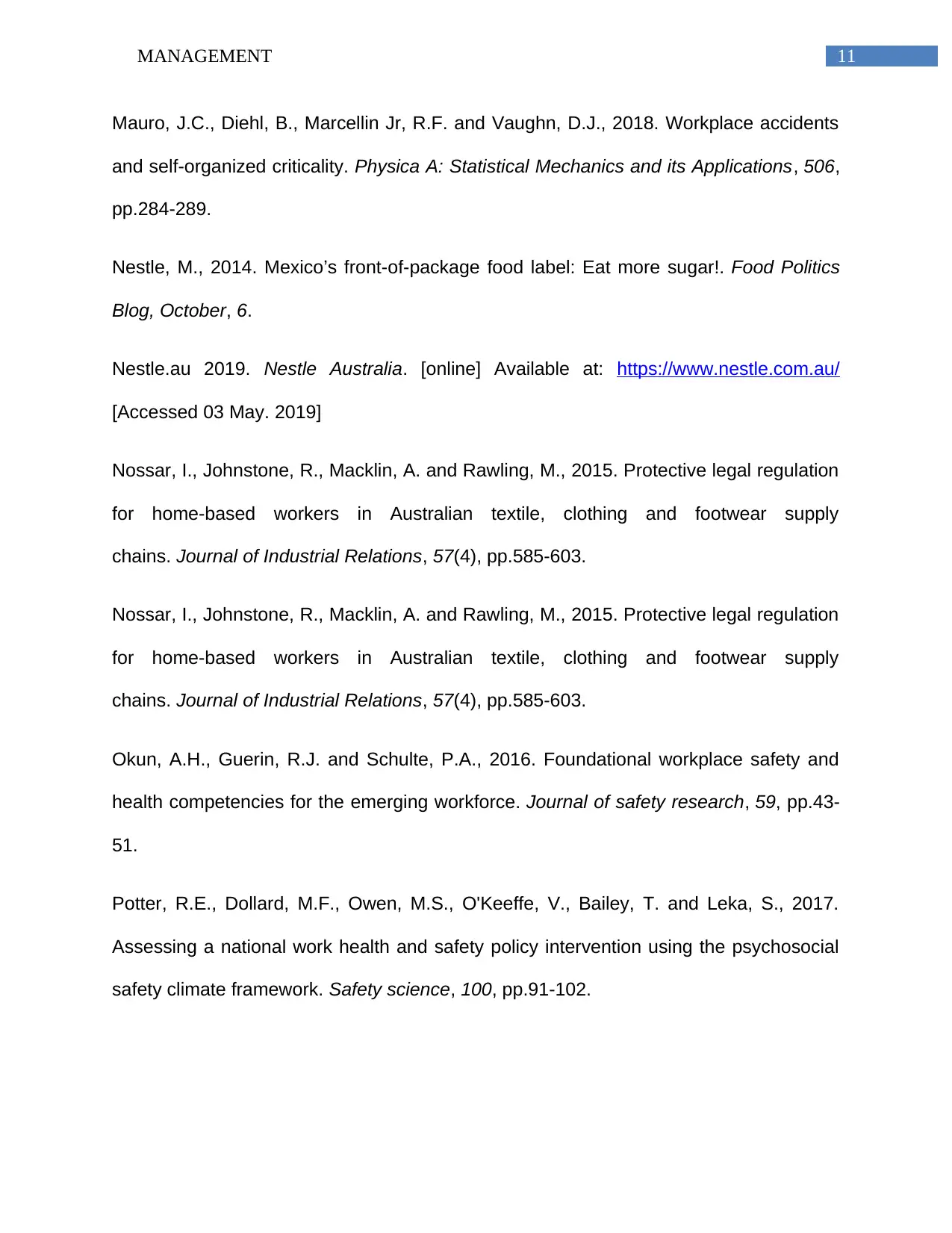
11MANAGEMENT
Mauro, J.C., Diehl, B., Marcellin Jr, R.F. and Vaughn, D.J., 2018. Workplace accidents
and self-organized criticality. Physica A: Statistical Mechanics and its Applications, 506,
pp.284-289.
Nestle, M., 2014. Mexico’s front-of-package food label: Eat more sugar!. Food Politics
Blog, October, 6.
Nestle.au 2019. Nestle Australia. [online] Available at: https://www.nestle.com.au/
[Accessed 03 May. 2019]
Nossar, I., Johnstone, R., Macklin, A. and Rawling, M., 2015. Protective legal regulation
for home-based workers in Australian textile, clothing and footwear supply
chains. Journal of Industrial Relations, 57(4), pp.585-603.
Nossar, I., Johnstone, R., Macklin, A. and Rawling, M., 2015. Protective legal regulation
for home-based workers in Australian textile, clothing and footwear supply
chains. Journal of Industrial Relations, 57(4), pp.585-603.
Okun, A.H., Guerin, R.J. and Schulte, P.A., 2016. Foundational workplace safety and
health competencies for the emerging workforce. Journal of safety research, 59, pp.43-
51.
Potter, R.E., Dollard, M.F., Owen, M.S., O'Keeffe, V., Bailey, T. and Leka, S., 2017.
Assessing a national work health and safety policy intervention using the psychosocial
safety climate framework. Safety science, 100, pp.91-102.
Mauro, J.C., Diehl, B., Marcellin Jr, R.F. and Vaughn, D.J., 2018. Workplace accidents
and self-organized criticality. Physica A: Statistical Mechanics and its Applications, 506,
pp.284-289.
Nestle, M., 2014. Mexico’s front-of-package food label: Eat more sugar!. Food Politics
Blog, October, 6.
Nestle.au 2019. Nestle Australia. [online] Available at: https://www.nestle.com.au/
[Accessed 03 May. 2019]
Nossar, I., Johnstone, R., Macklin, A. and Rawling, M., 2015. Protective legal regulation
for home-based workers in Australian textile, clothing and footwear supply
chains. Journal of Industrial Relations, 57(4), pp.585-603.
Nossar, I., Johnstone, R., Macklin, A. and Rawling, M., 2015. Protective legal regulation
for home-based workers in Australian textile, clothing and footwear supply
chains. Journal of Industrial Relations, 57(4), pp.585-603.
Okun, A.H., Guerin, R.J. and Schulte, P.A., 2016. Foundational workplace safety and
health competencies for the emerging workforce. Journal of safety research, 59, pp.43-
51.
Potter, R.E., Dollard, M.F., Owen, M.S., O'Keeffe, V., Bailey, T. and Leka, S., 2017.
Assessing a national work health and safety policy intervention using the psychosocial
safety climate framework. Safety science, 100, pp.91-102.
⊘ This is a preview!⊘
Do you want full access?
Subscribe today to unlock all pages.

Trusted by 1+ million students worldwide
1 out of 13
Related Documents
Your All-in-One AI-Powered Toolkit for Academic Success.
+13062052269
info@desklib.com
Available 24*7 on WhatsApp / Email
![[object Object]](/_next/static/media/star-bottom.7253800d.svg)
Unlock your academic potential
Copyright © 2020–2025 A2Z Services. All Rights Reserved. Developed and managed by ZUCOL.





